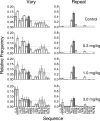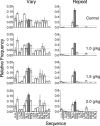Effects of D-amphetamine and ethanol on variable and repetitive key-peck sequences in pigeons
- PMID: 17191754
- PMCID: PMC1679968
- DOI: 10.1901/jeab.2006.17-06
Effects of D-amphetamine and ethanol on variable and repetitive key-peck sequences in pigeons
Abstract
This experiment assessed the effects of d-amphetamine and ethanol on reinforced variable and repetitive key-peck sequences in pigeons. Pigeons responded on two keys under a multiple schedule of Repeat and Vary components. In the Repeat component, completion of a target sequence of right, right, left, left resulted in food. In the Vary component, 4-peck sequences differing from the previous 10 produced food. d-Amphetamine (0.1-3.0 mg/kg, i.m.) was administered in two separate phases, separated by ethanol administration (1.0-2.0 g/kg, i.g.). Under control conditions, measures of variability were high in the Vary component, and lower in the Repeat component. Following administration of the highest dose of d-amphetamine, but not ethanol, response rates decreased in both components. d-Amphetamine and ethanol tended to increase overall sequence variability in the Repeat component, and had less of an effect in the Vary component. Performance in the Repeat component during Phase 2 of d-amphetamine administration was more disrupted than during Phase 1. Measures of variability and repetition based on shifts in the relative frequency distributions of the 16 possible keypeck sequences differed from those based on the overall measure of variability, highlighting the importance of considering both molar and molecular measures when assessing the effects of drugs on reinforced variability and repetition. In addition, the shifts in the relative frequency distribution of response sequences suggest that d-amphetamine produced decrements in repeat performance by decreasing discriminative control within response sequences, whereas ethanol decreased repeat performance by decreasing discriminability between components as well as discriminative control within response sequences.
Figures







References
-
- Baron S.P, Wright D, Wenger G.R. Effects of drugs of abuse and scopolamine on memory in rats: Delayed spatial alternation and matching to position. Psychopharmacology. 1998;137:7–14. - PubMed
-
- Bryant D, Church R.M. The determinants of random choice. Animal Learning & Behavior. 1974;2:245–248.
-
- Crow L.T. Ethanol-induced response stereotypy: Simple alternation, fixed-interval rates of response, and response location. Bulletin of the Psychonomic Society. 1982;19:169–172.
MeSH terms
Substances
LinkOut - more resources
Full Text Sources

